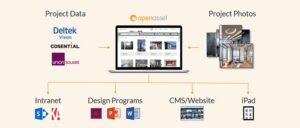How to Build a Marketing Technology (Martech) Stack
Mar 18, 2022

AEC Marketing Guide: Software To Include In Your Martech Stack
AEC marketing is unlike any other form of marketing because the AEC industry is unlike any industry. To succeed in AEC marketing you need to be more than an expert marketer. You need to be an AEC expert and have the expertise to not only provide a consistent brand image, but also capitalize on lead generation and enable business development.
It’s a tall order. Fortunately, there are tools to help you get it all done. This AEC marketing guide has everything you need to build the optimal AEC marketing tech stack for your firm.
What Is A Marketing Technology (Martech) Stack
Marketing technology (martech) refers to the software and technology that marketers use to attract and retain customers, but also communicate and collaborate internally. Designed to streamline and automate marketing processes, these tools are especially valuable to AEC marketers because they save time, improve productivity and generally make it easier for them to succeed.
Though many martech solutions have specialized appeal, they are useful to a wide range of different industries, and can be utilized by more than one marketing discipline.
In other words, you don’t have to be a marketer to benefit from the use of marketing technology. The following tools have broad appeal and multiple-use applications:
- Slack (Internal Communication, Project Management and Collaboration) – A proprietary business communication platform that offers many IRC-style features, including persistent chat rooms organized by topic, private groups, and direct messaging.
- Google Drive, DropBox (Cloud-based Repository and Content Creation) – File storage and synchronization services that enable users to store files in the cloud, synchronize files across devices, and share files.
- SAP, NetSuite and Oracle (Enterprise Resource Management) – Specialized software and services to manage business finances, operations, and customer relations.
- WordPress, HubSpot CMS (Content and Web Content Management) – Software used to manage the creation and modification of digital content by integrating document management and record retention.
- OpenAsset (Digital Asset Management and Cloud-Based Repository) – Software that enables AEC firms to organize, store and retrieve rich media assets, manage digital rights, and create proposals.
- Asana, Trello, Monday.com (Project Management and Collaboration) – Web and mobile applications that enable teams to organize, track, and manage their work.
How Does Martech Apply to AEC Marketing
Like any other marketing professional, AEC marketers use martech to be more productive and complete their jobs with greater ease and efficiency, but they also use them to fulfill a role left unoccupied by any other marketer in any other discipline – creating proposals.
Create High-Quality RFPs and Winning Project Proposals
AEC marketers are tasked with promoting the business and providing a consistent brand image, but they must also contend with a sales process reliant on proposals and RFPs.
Thus, AEC marketers give extra value to martech solutions that enable their team to produce high-quality visuals and manage the library of digital assets (images, videos, branding material, etc) used in the proposal/RFP creation process.
In fact, a recent survey of more than 500 AEC professionals revealed that 57% of AEC marketers said they leverage a DAM solution like OpenAsset to manage their images, brand material and other digital assets.
Among those already using DAM technology, more than 75% experienced higher productivity, increased efficiency and quicker turnaround times on proposals, RFP responses and other projects.
How To Build An AEC Marketing Technology Stack
The most important thing to remember when building a martech stack is that there is no one-size-fits-all approach. What works for one firm may not work for another. Let’s say, for example, that your primary focus is creating high-quality proposals that win more business.
Then you might add a creative suite (ex: Canva, Adobe Creative Cloud, etc.) to create a library of high-quality digital assets, and a digital asset management solution (ex: OpenAsset) to manage that library.
Alternatively, if your primary focus is SEO and paid ads on social media, then you might add tools like Moz, SEMRush and HootSuite. Overall, the martech solution you choose should align with your marketing strategy and enable your team to meet the goals of that strategy.
1. Identify Your Primary Marketing Strategies And Determine Your Goals
The first step to choosing the right martech tool for your firm is to outline your marketing strategy. Be sure to evaluate the strategies that are currently in place for areas that can be improved and/or existing features that you need to maintain productivity.
Let’s say, for example, that you wish to improve brand consistency. Then your strategy would be to implement a process for content creation and multimedia management. Write this strategy down in a document, then include ideas for possible tools you can use to implement that strategy.
Example Strategy:
- Goal – Improve Brand Consistency
- Strategy – Create process for content creation and multimedia management
- Tools – Content Management System (CMS) and Digital Asset Management (DAM)
2. Survey Your AEC Marketing Team To Identify Core Challenges
The next step in the martech selection process is to survey your marketing team for common challenges and/or processes that make it difficult for them to excel at their jobs. You’re looking for answers to questions like:
- What challenges do you encounter in the execution of your day-to-day duties?
- What adds time to your workflow?
- What makes your job harder?
Though you want to keep the conversation open-ended, it’s more important that you connect their challenges with your marketing goals. Let’s say, for example, that you want to improve the productivity of your marketing team.
Then you would ask a question like, “What is your biggest challenge when it comes to productivity?” If they say content creation or managing the firm’s library of marketing materials, you know that you should invest in a digital asset management solution. Jot these challenges down in the same document.
Example Strategy Cont. :
- Goal – Improve Brand Consistency.
- Strategy – Create process for content creation and multimedia management.
- Challenges – Content creation and management processes are inefficient.
- Tools – Content Management System (CMS) and Digital Asset Management (DAM).
3. Establish Your Budget And Allocate Funds To Martech Solutions
Once you have your strategy, it’s time to establish your budget. There are a number of ways to create a martech budget, like this ROI calculator. Alternatively, you can choose a budget for the entire team on a yearly, quarterly, or monthly basis.
4. Research AEC Marketing Technology Software Solutions
Now that you have your budget and your strategy, it’s time to research different martech solutions and build your AEC marketing tech stack. If you’re a marketing leader, this step can be assigned to individual team members, as they will be the ones using the tools.
It’s also helpful to look at product curation and buyers guide content to get a general idea of the service offerings and martech solutions that are out there. For the RFP and proposal creation challenges, you might look at Top Martech Integrations That Make Life Easier.
Post-Pandemic Trends Impacting AEC Marketing in 2021 is another great place to start, and a great source of information regarding the new tools, trends and technological advancements affecting other marketers in your industry.
5. Compile The Data For A Smooth Data Transfer
Once you have researched, selected and purchased your martech tools, it’s time to transfer the data. Depending on the size of your firm, this task is often carried out by the IT department.
If you do not have an IT department, your data transfer will likely require a team effort. Start by assigning a type of data to each member of your team (ex: one team member compiles leads from webinars. Another team member compiles property-photos, etc). Once the data is collected and compiled you can initiate the transfer.
Note: The data collection, compilation and transfer process is highly complex and often complicated. To ensure your data migration goes smoothly, we recommend that you read the following works on the subject and consult an expert if need be.
- Best Practice Advice for Marketing Data Transfer
- The Data Transfer Process in Corporate Transformations
- How to Consolidate Your Employee Data into a Single System
6. Establish A Workflow For Each Martech Solution
You’ve bought the tool and transferred your marketing data, digital assets, and everything else you need to promote your AEC firm. Now it’s time to create a workflow for each martech solution.
Assign an individual team member to explore one specific tool. Instruct that team member to write down workflow steps to use the tool effectively. If possible, instruct them to create a step-by-step tutorial with screenshots.
Then schedule a meeting for the team member to conduct a live tutorial with the rest of the marketing team. This single uniform process guarantees that every team member uses the tool to its fullest extent.
7. Analyze Success. Switch Martech Solutions If Necessary
A few months after your new martech solution is up and running, it will be time to see if the solution is working/being used the way you intended. The last thing you want is to pay for an expensive software subscription that your team does not utilize.
Start with an audit of your new martech solutions to determine if they effectively streamline workflows, automate tasks, and enable your team to work more efficiently and be more productive.
If your audit determines that the software is not working properly, or your team does not believe it to be useful, the best thing you can do is switch solutions before you pay any more money for a tool you no longer need.
How To Find A Martech Solution That Scales With Your Firm
AEC firms and marketing teams are close-knit. News that you are building a new martech stack will travel fast. Before you know it, team members from different departments will try to influence your decision, and complicate the above process to address urgent gaps.
We hear you. OpenAsset’s marketing operations team knows all too well how difficult it can be to find and incorporate martech solutions that scale with your business and grow with your team.
We’ve learned a lot along the way and aim to share what we know with you, our colleagues in the AEC marketing community. Below you will find insight from our resident marketing operations (MarOps) experts who explain what they wish they had known when they built the martech stack we use at OpenAsset.
Start With a Demo
According to Carina Ratcu, Head of Demand Generation with OpenAsset, the best way to select the right martech tools from the 8000+ tools on the market is to start with a demo.
“I tend to set up a few demos with the top ones and run them through an objective, standardized set of questions, very similar to an RFP process. This is very helpful to make sure you don’t get ‘swoon’ by the cool websites and features, but rather concentrate on what makes sense for your business and is critical to enable your team. We all work in marketing after all and know how impactful a good website can be.”
Emphasize Reporting and Training
According to McKenzie Ellis, Director of Content and Brand at OpenAsset, AEC firms should emphasize the importance of solid reporting and analytics when building their martech stack.
“Otherwise, there is no way to tell if your marketing strategy is actually working. Beyond that, the best thing you can do is ensure your marketing team has the skill set to operate the platform efficiently. If not, the vendor should offer to train your team on the best way to utilize the platform.”
Choose Point Solutions That Serve a Single Purpose
A point solution is software that addresses one very specific need. “Sometimes you just need a piece of software to do a specific thing,” says Jacob Siuda, Content Marketing Specialist at OpenAsset, “but keep in mind that every piece you add to your infrastructure comes with technical challenges.”
If you have any point solutions in your current martech stack, consider how it fits into your marketing strategy and the firm as a whole. How does the solution interact with the rest of your tech stack and what does it need to run?
Best AEC Marketing Technology (Martech) Stack for 2022
The best martech stack for your AEC firm should be tailored to your needs. That said, here are our recommendations for a martech stack that will scale with your firm and grow with your team.
We’ll start with martech solutions for collaboration and communication, then move on to martech tools for project management, content creation and digital asset management.
Collaboration: Google Drive (Alt. DropBox, OneDrive)
Google Drive (including docs, sheets, slides, forms, etc) enables your AEC marketing team to collaborate on documents, spreadsheets, and folders via the cloud, which eliminates the need to download software to their laptop. The best part is that the cloud makes it nearly impossible to lose work.
Communication: Slack (Alt. Microsoft Teams)
Specifically designed for work chat, Slack is an instant messaging platform that makes it
easy for your marketing team to share quick updates, send files, and communicate live if necessary. Slack makes chatting so easy that it nearly eliminates the need for emails.
Project Management: Asana (Alternative: Trello)
It doesn’t matter what you promote or who you brand, marketing is nothing without project management. From scheduling campaigns and creating content, to responding to RFPs and writing proposals, you need a solution that keeps things on track. Designed as a collaborative space for your team to check off tasks and share project updates, tools like Asana and Trello make collaborating with team members easier than ever.
Content Management: WordPress (Alternative: HubSpot CMS)
If your firm does not yet have a website or blog you need to create one ASAP. To get started you will need a scalable CMS system to power your website. WordPress and HubSpot are the most popular CMS tools among marketers today, but there are a number of alternative CMS solutions that enable you to build landing pages, create forms, add pop-up CTAs, publish blog posts, and see all of your performance metrics.
Digital Asset Creation: Canva (Alternative: Adobe Creative Cloud)
Content and other digital assets are critical to any marketing and branding strategy. For this purpose, content creation tools like Canva and the Adobe Creative Cloud are great options that offer a wide range of helpful templates to help your marketing team create things like:
- social media posts,
- Facebook banners,
- posters,
- infographics,
- presentations,
- flyers,
- brochures and more.
Stock Images: Unsplash, Pexels, Shutterstock, Getty Images, iStock Photos
It’s illegal to use images found online unless they’re under a Creative Commons license – that’s where stock image sites like Unsplash and Shutterstock provide enormous value.
Digital Asset Management: OpenAsset
Now that your team is up and running with document, content and multimedia creation, you need a way to store, share and manage all of those digital assets. For this process, there is no better solution than OpenAsset, the preferred DAM solution for AEC firms around the world.
Unlike traditional DAM solutions, OpenAsset is designed specifically for AEC marketers. Its innovative property-based configuration makes it easy to:
- view projects and properties clustered as real-world locations;
- provide file access to all teams across your entire network;
- search your digital assets using simple keywords;
- create impressive bids and proposals;
- combine key data sources with your digital assets, and more.
Stay Up To Date on AEC Marketing and AEC Martech Solutions
We hope this guide on how to build an AEC marketing tech stack was helpful. As you go about building the martech stack for your firm, remember that there are a lot of martech solutions out there, but only one combination that is perfect for your team.
There is also no need to settle for clunky, complex, and time-consuming legacy software, since the best martech solutions combine power, efficiency and ease-of-use. Contact OpenAsset today to schedule a demo of the only martech solution designed specifically for firms in the built world.





